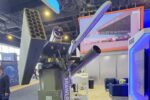AimLock and Overland AI have announced a strategic partnership to integrate their respective technologies—precision robotic weapon control and autonomous ground navigation—into a unified system. This collaboration aims to deliver a fully autonomous tactical ground vehicle capable of executing multi-mission tasks in denied or contested environments without direct human control.
Combining Precision Fire Control with Autonomous Mobility
The core of the partnership lies in merging AimLock’s “lethality stack”—a suite of software and hardware enabling precision targeting and engagement from moving platforms—with Overland AI’s “OverDrive,” an autonomy stack designed for uncrewed ground vehicles (UGVs). The resulting platform is envisioned as a modular, mission-adaptable UGV capable of operating without GPS or continuous communications—a key requirement for future battlefield relevance.
AimLock’s fire control systems are already in use on manned platforms such as helicopters and tripods. Their technology enables automated target acquisition (ATA) and robotic stabilization of weapons during movement. By integrating this with OverDrive’s perception-driven navigation—developed under DARPA’s Robotic Autonomy in Complex Environments with Resiliency (RACER) program—the companies aim to build an end-to-end autonomous combat system that can maneuver tactically while engaging targets independently.
Modular Multi-Mission Capabilities
The joint solution is designed around modularity. While initial prototypes focus on kinetic effects—such as integrating AimLock’s stabilized weapon mounts onto Overland-equipped UGV chassis—the architecture supports plug-and-play payloads including ISR sensors, EW modules, CBRN detection kits, or logistics pods. This flexibility aligns with emerging doctrinal concepts like “mosaic warfare” and modular open systems architecture (MOSA), allowing rapid reconfiguration based on mission needs.
Use cases envisioned by the partners include:
- Autonomous perimeter defense with lethal/non-lethal deterrents
- Forward-deployed scout-killer roles using onboard sensors and weapons
- Urban reconnaissance under GNSS-denied conditions
- Force protection at forward operating bases or critical infrastructure
- Human-machine teaming where the UGV acts as a remote shooter under human-in-the-loop ROE
A Response to Modern Battlefield Demands
The AimLock–Overland integration reflects broader trends in defense robotics emphasizing autonomy at the edge. As peer adversaries invest heavily in electronic warfare (EW), GPS jamming/spoofing, and long-range fires, reliance on remotely piloted or teleoperated systems becomes increasingly untenable. Fully autonomous systems that can navigate complex terrain using onboard sensors—and make engagement decisions within defined rulesets—are rapidly becoming operational imperatives.
This is particularly relevant given recent battlefield lessons from Ukraine, where FPV drones have demonstrated high lethality but limited survivability due to EW vulnerabilities. A more resilient ground-based solution that combines mobility with precision strike capabilities could fill critical gaps in layered defense architectures.
Technical Foundations: RACER Program Legacy
Overland AI’s autonomy stack builds directly on its work under DARPA’s RACER program—a high-profile initiative aimed at developing off-road autonomy for uncrewed vehicles operating at speed through unpredictable terrain. Unlike traditional path-planning algorithms reliant on pre-mapped data or GNSS inputs, RACER-derived autonomy uses real-time perception via EO/IR cameras and LiDAR to interpret terrain features dynamically.
This allows the UGV platform to navigate forested areas, urban rubble zones, or mountainous regions while maintaining situational awareness—all without needing external comms or satellite positioning. When paired with AimLock’s ATA-enabled weapon mounts—which can track moving targets even while the vehicle is bouncing over rough terrain—the system becomes uniquely suited for expeditionary operations where humans cannot safely operate.
Ethical Considerations and Human-in-the-Loop Controls
The integration of autonomous navigation with lethal effectors inevitably raises questions about command authority and ethical constraints. Both companies emphasize that their joint solution supports scalable levels of autonomy—from full manual operation to semi-autonomous modes requiring human confirmation before engagement (“human-on-the-loop”), up to fully autonomous operation within pre-approved ROEs (“human-out-of-the-loop”).
This flexibility allows commanders to tailor use depending on legal frameworks, theater-specific rules of engagement (ROE), or operational risk assessments. Given ongoing debates around autonomous weapons systems (AWS) at the United Nations Convention on Certain Conventional Weapons (CCW), such design choices will likely be scrutinized both technically and politically.
Program Status and Future Outlook
No formal program-of-record has yet been announced linking this integrated platform to any specific U.S. military procurement initiative. However, both companies are actively engaging DoD stakeholders—including Army Futures Command (AFC), SOCOM’s SOFWERX innovation hub, and Marine Corps Warfighting Lab—for potential experimentation opportunities under OTAs or SBIR pathways.
If successful in early demonstrations—potentially via Project Convergence exercises or DARPA field trials—the integrated AimLock-Overland system could become a candidate for future programs focused on manned-unmanned teaming (MUM-T), robotic wingmen concepts for infantry squads, or base defense automation initiatives like SENTRY-AI.








